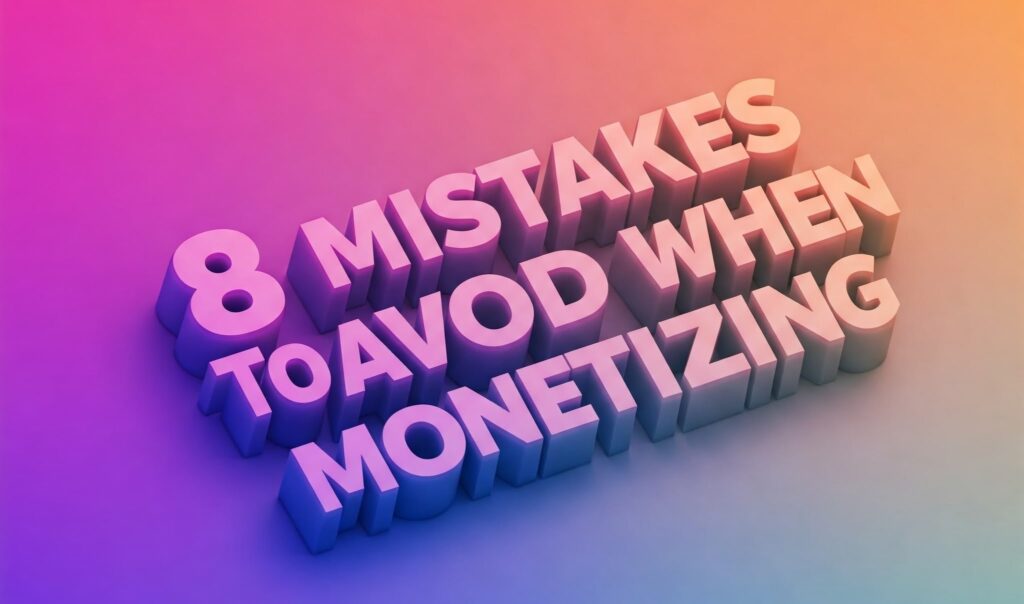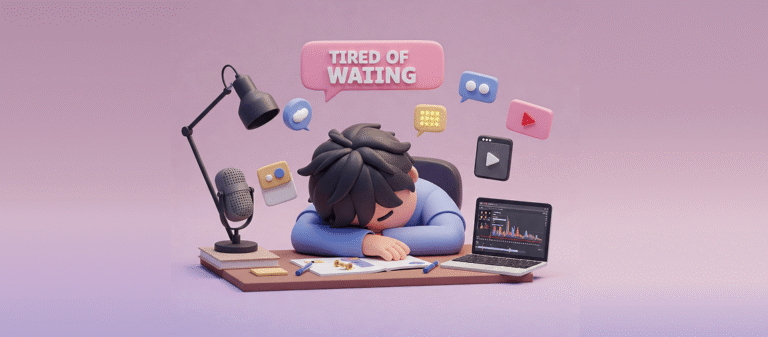Monetizing your passion sounds exciting, but it’s shockingly easy to trip up and hurt both your income and audience trust. Below, we’re tackling five of the most common blunders creators make when trying to turn their content into cash—and sharing how you can dodge these pitfalls to build a healthier, more profitable brand presence.
1. Promoting Products That Don’t Match Your Content
❌ The Mistake: Rushing into random partnerships—or pushing trendy items that have zero relevance to your usual topics—might snag a quick buck, but it also confuses and alienates your followers. They followed you for your food reviews, but suddenly you’re hawking gaming chairs out of nowhere?
➡️ The Consequence: If your content feels too sales-driven, audience burnout becomes a real risk—viewers may scroll right past you the moment they sense a pitch. Over time, this leads to waning engagement and trust, especially from loyal fans who start to doubt your authenticity. They may wonder if you genuinely love the products you promote or if you’d simply endorse anything for a quick buck. And once that suspicion sets in, it’s tough to win their confidence back.
✏️ How to Fix It: Start by narrowing down your niche and asking whether the partnership genuinely aligns with your usual topics or core values. If you focus on eco-friendly living, for example, collaborating with a zero-waste brand makes sense—whereas endorsing fast fashion could feel inconsistent. From there, think about adding real value when you promote something. A short demonstration or honest mini-review can go a long way in highlighting why your followers might actually benefit from the product, rather than making them feel like they’re just being sold to.
2. Overlooking Disclosure (or Hiding Your Affiliate Ties)
❌ The Mistake: Some creators believe skipping disclaimers about affiliate links or sponsored posts makes them seem more “authentic.” They’ll slip in promotions without labeling them, hoping followers (and regulators) won’t notice.
➡️ The Consequence: This practice can land you in legal hot water. The FTC in the U.S., and equivalent bodies elsewhere, require clear disclosure of sponsored content or affiliate relationships. Beyond potential fines, you also risk eroding trust with fans who feel duped once they realize you’re being paid. Losing that trust can be devastating for a content creator’s long-term success.
✏️ How to Fix It: Be upfront about your affiliations. Mention “sponsored” or “affiliate” in your captions or within your videos, and clarify that while you earn a commission, you’ll always provide honest opinions. Most followers appreciate the transparency and prefer to know how you make a living rather than being kept in the dark.
3. Flooding Your Feed with Too Many Sponsored Posts at Once
❌ The Mistake: When multiple brand deals line up, it’s tempting to post them all back-to-back. While it may briefly boost your income, it can also make your feed feel like an endless advertisement reel, overshadowing your usual content.
➡️ The Consequence: People can get annoyed by nonstop promos, start tuning out, or skip your posts altogether. The brands you’re promoting suffer too, since their messages compete for attention in what feels like a cluttered, sales-heavy feed. This can diminish the effectiveness of each individual campaign.
✏️ How to Fix It: Create a mini editorial calendar to spread out your sponsored content. If you have deals lined up, schedule them with gaps that let you post your usual style of content in between. This approach ensures each partnership has room to shine, while your followers still get the authentic material they originally followed you for. Being more selective about which deals you accept also helps maintain balance and consistency in your feed.
4. Ignoring Audience Data and Feedback
❌ The Mistake: Some creators post ads or sponsored posts blindly without looking at what their followers respond to. They never check analytics (like saves, shares, or comments) to understand which content types genuinely resonate. As a result, they push offers their audience doesn’t truly want.ur usual content.
➡️ The Consequence: When followers feel they’re being offered irrelevant or low-quality products, conversions remain low. The brand might see poor ROI, and you waste time and effort on campaigns that fall flat. Repeated mismatches can harm your reputation, with followers wondering if you care about their needs at all.
✏️ How to Fix It: Study your platform’s insights regularly. See which topics generate consistent engagement, then choose sponsorships that align with those interests. If you’re still uncertain, ask your followers directly—run a quick poll or pose a question in your captions. Tailoring your campaigns to audience feedback fosters a sense of collaboration, increasing the odds your monetized content will succeed.
5. Forgetting to Refresh Affiliate Codes or Links
❌ The Mistake: Once a link or discount code goes live, it’s easy to assume it’ll remain valid indefinitely. In reality, brands update links, affiliate programs shift, or codes expire over time. Neglecting to check can create a patchwork of dead ends.
➡️ The Consequence: Users who click a link and find a broken page or a code that no longer works may feel frustrated or misled. You also forfeit potential commissions every time someone encounters an invalid link. From an SEO perspective, broken links can signal to search engines that your content is outdated, which may impact your rankings.
✏️ How to Fix It: Schedule periodic link checks—maybe once a quarter or after major sales seasons if you’re in a fast-moving niche. Verify that your affiliate codes still provide valid discounts. Update or remove anything that’s expired or irrelevant so you don’t unintentionally push outdated deals.
6. Missing a Clear Call to Action (CTA)
❌ The Mistake: Crafting visually appealing or deeply informative posts but never telling followers the next step—like where they can buy the item, sign up for your email list, or grab a discount code.
➡️ The Consequence: Even if your content intrigues people, they won’t know how to act on that interest. You lose out on clicks, sales, or new subscribers simply because you didn’t nudge them to do something.
✏️ How to Fix It: End every sponsored post, affiliate mention, or relevant piece of content with a direct prompt, such as “Use my code at checkout” or “Tap the link in my bio.” The tone can stay casual (“Curious? Click here!”) but make sure the direction is obvious, so there’s no guesswork involved.
7. Relying on One Platform—or One Monetization Method
❌ The Mistake: Some creators lean solely on YouTube AdSense, Amazon Associates, or brand sponsorships, forgetting that no single monetization channel is guaranteed to stay lucrative forever. A policy change can quickly undercut your revenue.
➡️ The Consequence: Your income becomes unstable if the platform adjusts its algorithm, lowers payout rates, or ends a program. You also restrict your potential growth by not exploring other revenue sources like digital product sales, membership sites, or offline partnerships.
✏️ How to Fix It: Diversify your streams. Combine affiliate marketing with brand deals, launch a Patreon, or sell your own digital courses. If you want a broader range of campaign types (Cost-Per-Lead, Cost-Per-Sale, etc.), consider using a flexible performance marketing platform like Crelora. Spreading out your efforts minimizes the blow if one channel falters.
If the idea of juggling multiple affiliate deals and sponsorships feels overwhelming, Crelora can help streamline your monetization efforts. Instead of sticking to just cost-per-sale or a single revenue model, you can explore diverse objectives—like cost-per-lead or cost-per-install—all under one roof. It’s an easier way to diversify income without the hassle of signing up for a dozen different networks.
8. Setting Unrealistic Rates—or Underselling Yourself
❌ The Mistake: Some creators overcharge before proving their worth, while others underprice so severely they barely earn anything. Both can harm your reputation and income.
➡️ The Consequence: Overpricing might send brands running if they think you’re out of touch, while underpricing can lead to burnout or being pegged as “cheap.” Raising them down the line becomes a challenge once people get used to your low rates.
✏️ How to Fix It: Do some market research to gauge typical fees for creators in your niche. Emphasize the strength of your engagement; micro-creators often command higher rates than they realize when they show proof of a dedicated, interactive audience. Keep your pitch grounded in real data, and adjust prices as you build a track record of successful campaigns.
Avoiding these eight pitfalls is crucial if you want to transform your creative passion into a sustainable income source. Each mistake—from random product mismatches to ignoring data—can erode both earnings and audience trust. But with a touch of strategic thinking, genuine transparency, and smart diversification (like exploring Crelora’s flexible campaigns), you can build a monetization plan that feels true to you and genuinely benefits your community. After all, the goal isn’t just to make money, but to do so in a way that preserves what makes your content special in the first place.




